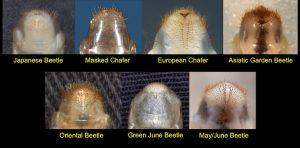In the Northeast, beetles are currently flying. Accordingly, they’re laying eggs throughout July. These eggs turn into grubs that feed on the root systems of turf. A grub infestation can take down a lawn, so know how to treat grubs organically.
Types of Beetles that tend to be of concern:
- European Chafer: a troublesome species in New Hampshire and eastern Massachusetts.
- Japanese Beetle: perhaps the most widely distributed grub species in New England.
- Asiatic Garden Beetle: fairly widespread in southern New England.
- Oriental Beetle: common in the coastal regions.
Reasons for Grub Decline
We’ve seen fewer instances of grubs through the years. This decrease likely due to the following factors:
- Removal of Attractor Plants — we’ve made it a point to recommend the removal of attractor plants. Roses, Japanese maple, grapes zinnias, and mountain ash all help to bring beetles to town.
- Healthier Soil Food Web — soils with healthy biodiversity increase earthworms, ants, springtails, fungi and bacteria—all potential predators to feed on beetle eggs.
- Drought Conditions — grubs require high soil moisture for egg survival. So, grub populations do best in soil that are consistently moist from late June into September. Perhaps another reason to avoid irrigating your lawn throughout the summer and simply allow it to go dormant.
- Mowing High — contributes to a more vigorous root mass allowing it to better withstand the chance of damage from grubs feeding on the roots.
While we may not be seeing the typical number of Japanese beetles, they still pose concern. In addition, keep in mind that European chafers are night fliers so you may not know they’re out and about. As for Asiatic Garden and Oriental beetles, we just assume they’re around.
How to Scout for Grubs

Source: “Turfgrass Insects: Department of Entomology”, Purdue University Extension-Entomology.
It is best to scout for white grubs in early – mid September. To scout, cut three sides of a square turf section, about one square foot in size. Fold
back the turf and examine the roots about 3 – 4” deep. Count the number of white grubs you find. You may wish to do this in at least 3 to 4 different spots around the lawn.
Treating Grubs in Your Lawn
If you find more than 7–8 grubs per area, it is best to treat. The last several years we treated using cedar oil out of a backpack sprayer. We used to have a lot of success treating with hB nematodes. Although, nematodes are aquatic and require moist soil conditions to move around. With how dry it has been the past few years, in addition to water bans, we have not found conditions favorable for hB nematodes to be an effective treatment option.
PJC’s recommended Cedar Cure controls white grubs and other pests. This product triggers the erosion of the exoskeleton of insect eggs and larvae, which results in their dehydration, subsequently rendering their pre-life status DBH (dead before hatch). Visit our product page for more info, or contact us for product pricing. Now that you know how to treat grubs organically, stay on top of it—your lawns will thank you!
